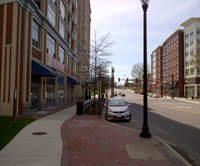Columbia Pike’s Form Based Success
This article was originally published on the Arlington Virginia Newsroom website, August 6, 2015
Efforts to transform Columbia Pike into a more walkable transit-oriented “Main Street” for south Arlington, spelled out 12 years ago in the Form Based Code development tool, are becoming a reality.
Multiple projects with new ground floor retail, topped with apartments, condominiums or offices, have opened. Building heights and densities have increased but with less intense development that has a more human scale than the development in Arlington’s metro corridors.
Today’s Columbia Pike boasts a Giant grocery store, a public plaza, a community center, wider sidewalks, benches and trees. All this is turning the heavily traveled corridor, once just a place for cars to zoom through, into the sort of place where folks can stroll, sit, shop, eat and get together, and where residents of the surrounding neighborhoods can walk or take transit to services and entertainment. In 2014, the Congress for New Urbanism named the community’s plan for the Pike the “Best Corridor Plan” in the nation.
“The projects we have done in the last 12 years have been mixed-use projects,” said Jennifer Smith, a principal planner with the County who worked on the Columbia Pike Neighborhoods Area Plan. “There are sections now with thriving retail, a public plaza, walkability to a grocery store — it is really becoming a Main Street. For placemaking and overall revitalization, this has been a success.”
Smith and Matt Mattauszek, another County planner who works with the Pike, attribute the transformation to the County’s adoption of the 2003 Form Based Code zoning tool for the commercial areas along the three-and-a-half miles of the Pike within Arlington, running from the Pentagon to Fairfax County. The County also adopted a second Form Based Code, for residential neighborhoods, in 2013.
A decade ago, Form Based Code, which uses physical form instead of separation of uses to regulate development, was a fairly new approach to zoning. It had never before been tried in the Commonwealth, and had rarely been applied to already developed areas anywhere in the nation. After a lengthy community process, the County adopted the Commercial Form Based Code to implement the vision established in the Columbia Pike Initiative. It offered developers incentives, including a streamlined review process, the possibility of higher density and height beyond the by-right zoning, all in exchange for following specific regulations detailing building and parking placement, historic preservation, streetscape improvements and architectural features.
Since adoption of the commercial Code, 13 projects have been approved along the Pike with another four under review. More than 1,900 residential units, more than 210,000 square feet of commercial space, 52,300 square-foot Arlington Mill Community Center, a public plaza and the Giant supermarket have been added to the Pike.
It is still very much a work in progress, Smith said. “We still have pockets that have not yet been redeveloped, but look how long it took to redevelop the Rosslyn-Ballston corridor — and Metro was a powerful catalyst there.” And Form Based Code, she noted, is “not about architecture, it is about getting the overall massing right, the width of sidewalks, the transparency of ground-floor windows.”
The County has helped spur redevelopment efforts by investing heavily in transportation infrastructure and service along the Pike — from the ongoing multi-modal project that is improving traffic flow, intersections, streetscapes and burying utility lines, to vastly improved bus service that has put more buses on the Pike, running more frequently and making more connections to Metro and other areas of the County.
Although the November 2014 cancellation of the planned streetcar was a setback, Smith and Mattauszek said, they have seen no falloff of interest from developers.
“We have four projects under review right now for the Pike and most of those were initiated following the streetcar decision,” Mattauszek said.
The County is now developing, as part of its state-mandated Transportation Development Plan update, long-range transit alternatives for the Pike. The County’s transportation staff is currently analyzing the County’s current transit system and the results of a Countywide transit survey, and will make preliminary recommendations for new transit service and capital enhancements this winter.

















1 Reply
Trackback • Comments RSS
Sites That Link to this Post